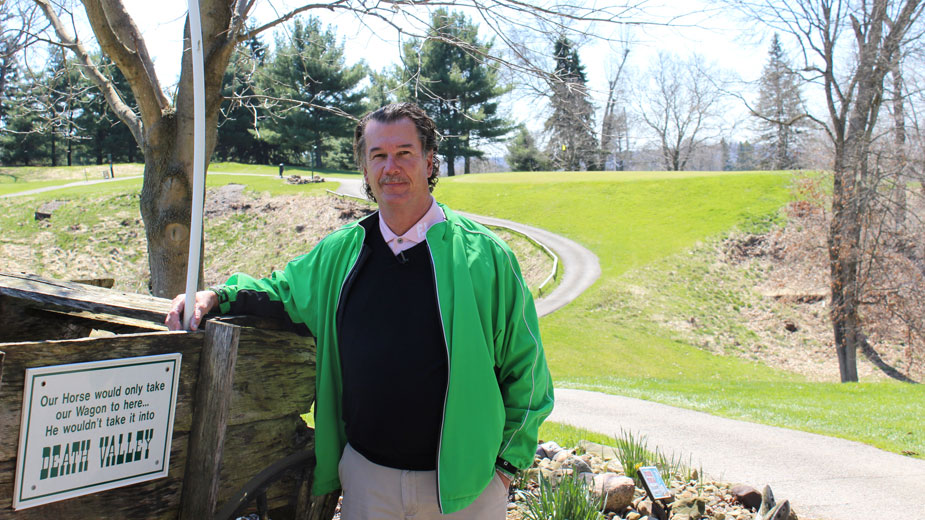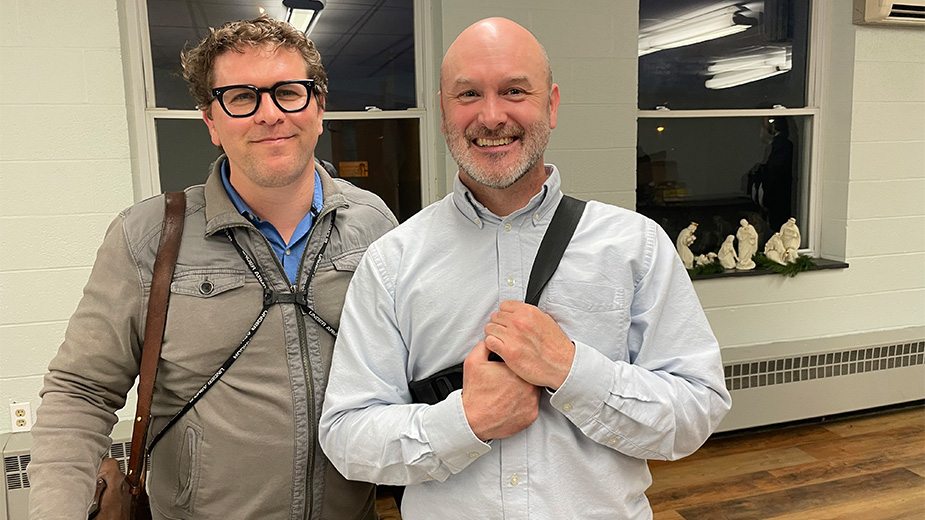Not Par for The Courses Even for Golf Pros
YOUNGSTOWN, Ohio – As we drive around the Pine Lakes Golf Club in Hubbard, director of golf Chris Carfangia stops to ask golfers which hole at the course is the most difficult. The answers are all the same: the final hole, No. 18.
At some courses, it’s easy to figure out which is the hardest. But at others it can be more nuanced, often coming down to personal experience.
“It could be nine. It could be 11,” says the Kennsington Golf Club’s director of golf, Ron Glove. “It could be 13. It could be 18. Each one has its own challenges.”
Whether it’s the length of the hole, the contour of the green or the curve of the fairway, each course in the Mahoning Valley has its own most challenging hole to play. Each of the following nine holes has unique elements that led the course professional to choose it as the most challenging at his course.
Some chose a hole for its topographical features, others for its distance, and yet others for the arrangement of the green. Where possible, we’ve provided a diagram of the hole.
Whatever sets one hole apart from the 17 others, each can be sure to provide a challenge to golfers of all skill levels.
Avalon Lakes, Hole 8, Par 3, 244 Yards
Golf course designer Pete Dye has called the eighth hole at Avalon Lakes Golf & Country Club, Warren, one of the hardest par 3s he ever created, says director of golf Adam Scott. As you follow the cart path up to the tee box, it’s easy to get psyched out by the layout.
It’s a short hole, with tee boxes between 244 and 129 yards, and a water hazard that runs the entire left side of the fairway and green before wrapping around the green to form a peninsula. Along the entire right side of the fairway are bunkers buried among small hills.
Many golfers favor hitting their balls into a bunker rather than take the penalty for playing into the water. But, Scott notes, that doesn’t always work out well.
“People don’t want to go anywhere near that water. But if you put your ball into a bunker, then guess what: you’re still hitting it toward the hazard.”
There’s nowhere to hit the ball but straight.
“You can’t miss long. You can’t miss left. You can’t miss right. There is absolutely nowhere to miss your shot,” Scott says. “The only place you have to go is about 10 yards from the pin in any direction.”
Even when you get your drive onto the green, there’s still plenty of work to do.
A few spots on the green dip toward the water on top of the right-to-left slope, dooming errant putts, and the green is long – almost 70 yards at its maximum.
“If the pin is at the back of the green when you play, even with a solid drive, that can be a 180-foot putt,” Scott says. “That’s tough for anyone.”
Avalon at Buhl Park, Hole 8, Par 4, 406 Yards
Marking the start of the “Amen Corner” at Avalon at Buhl Park, Hermitage, Pa., is the eighth hole that often gives golfers fits, says director of golf Adam Scott.
With a left dogleg and an uphill fairway, the green – and even the flag – are hard to see from the tee box. After the bend in the fairway, bunkers lie on both sides of the two-tiered green. The front of the green also slopes toward the fairway, leaving golfers who play it short with a tough shot to make.
“You don’t really know where you’re going and it’s uphill,” Scott says. “If you hit up the left side, you have to be sure you clear the corner. If you go up the right side, you can play it a little bit shorter at the expense of being a lot further back from the green.”
For the average golfer, Scott recommends playing the right side of the fairway to get in view of the hole, making play a bit easier. From there, a solid second stroke as close to the green as possible is important to set up par.
“If you can see the green, you can hit the green,” he says.
For many golfers on this hole, bogey is common, setting the tone for the “Amen Corner” of holes eight through 11.
“This starts a tough stretch of holes, so not many people like this one,” he says. “It’s challenging, especially for shorter hitters because you have to get far enough up the course to have a chance at par.”
The hole does get easier over time, he notes, as you learn the ins and outs of the hole and just where to place your shots.
“When I first started playing here, I couldn’t even get my tee shot to the top of the bend,” he says. “It’s gotten a lot easier over the years.”
Kennsington, Hole 13, Par 3, 232 Yards
Even with a good tee shot over a gulley and onto the green, there’s still plenty of challenge on the 13th hole at Kennsington Golf Club, Canfield. The green is plenty wide enough to handle slices or hooks, but the narrowness makes overshooting or undershooting a difficult obstacle to overcome.
Once you’re on the green, there are the hills and ridges to play through to get to the pin, and all the while the green slopes toward the gulley to separate the tee box and green.
“If you go too long, you’re dead. You have to hit the pin,” says director of golf Ron Glove. “It’s probably a bit easier to play the hole high. If you get the ball below the hole, you’ll have a tough time with your putt.”
As a testament to the strategy, along the hill backing the green are golf balls left behind after drives went long.
“Some guys won’t even try it if it ends up on the hill,” notes caddie Gino DiVicenzo. “The green goes every which way and they don’t want to risk playing it into the ditch.”
Adding to the challenge is the visual element, Glove continues.
Because of the hill on the back, the ridges on the green and the gulley in front, it can be hard to judge just where to aim.
“That’s what really makes this different from our other difficult holes,” he says. “There’s not much for a frame of reference for how a ball will move. Combined with the break of the green, that’s what makes this so difficult.”
Adds DiVicenzo, “We have a few hard holes here, but 13 has character. That’s what makes it the most challenging.”
The Lake Club, Hole 2, Par 4, 442 Yards
Several factors come together to increase the difficulty of the second fairway at The Lake Club in Poland: the left dogleg shape, the left-to-right slope, the trees along the right side and wind that often blows from left to right.
The result of that combination, says director of golf Dennis Miller, is many players ending up on the wrong side of the course.
“For most golfers who slice the ball, the ball is already moving left to right. Once it hits the ground and that slope, it will continue that movement and go into the trees,” he explains.
But, he notes, just around the bend of the dogleg is a fairly large pocket of rough to catch shots that venture too far left. The shot from there back onto the fairway is much easier than trying to play out of the trees on the other side of the fairway.
“From there, you’ll need a mid- to high-iron, maybe even a hybrid, for the second shot onto the undulating green,” Miller concludes.
The green continues the slope of the fairway. If the second shot lands above or on the right side of the pin, it can be very hard to complete the hole in just four strokes.
“Most guys would take a bogey and run with it,” Miller says. “Everything is challenging. Even on the green, there are no bargains. The entire hole is tree-lined. It’s a dogleg going against a slope. There’s a prevailing wind.”
Mill Creek North, Hole 9,Par 4, 440 Yards
There is no one thing that makes hole nine on the North Course the most challenging, says the director of golf, Brian Tolnar, at Mill Creek Golf Course in Boardman, and that’s just the way Donald Ross designed it.
“He really wanted you to think about how you were going to hit the shot and approach the hole,” Tolnar explains. “It isn’t enough to just drive it as hard as you can. If you do that, you’ll end up in the water or out of bounds.”
With tall trees lining the left side and a creek running across the bend in the fairway, there’s not much space to land a drive here.
“This tee shot is extremely demanding,” he says. “You really have to place your shot into a small area.”
That area is about 20 square feet straight out from the tee box, favoring the right side of the course. The trick, Tolnar adds, is to aim for the bridge over the creek or the driving range’s shed.
Foliage often comes into play in summer and fall, eliminating many chances for a drive that carries through the trees and sending plenty of shots out of bounds.
“It can be like playing under an umbrella here,” the golf director says. “And having been in the trees myself, I can tell you firsthand how difficult it can be to get out of them and make par or even bogey.”
Once golfers are over the creek, a bunker to the left of the green can provide some extra challenge to the hole. But with a solid tee shot and good second stroke, Tolnar says, the green shouldn’t ruin any scores.
“There’s no place you want to fall asleep here, especially the finishing holes of each course,” he says. “But this is the most demanding because you have to work through everything to set yourself up for the back half.”
Pine Lakes Golf Club, Hole 18, Par 4, 430 Yards
Barely changed since the course opened in 1926, it’s the final hole at Pine Lakes Golf Club, Hubbard, that gives players fits, says director of golf Chris Carfangia. The biggest challenge here is that the hole is almost entirely uphill until you reach the green.
“The ball doesn’t go anywhere once it lands. It doesn’t necessarily roll back, but it just hits and stops. There’s nothing extra once it lands,” he says.
Golfers also have to contend with a right dogleg closely guarded by the tree line and a green sloping away from the pin “almost like it’s crowned right in the middle,” Carfangia says.
Because of the break on the green, a strong second shot “with more club than you think you need” is crucial to getting on the green and to avoid exceeding par. Once on the green, many golfers can be thrown off by the smaller-than-normal size of the green, a remnant of the style popular when the course was built, and the crowning on the hole, sloping away from the pin in almost every direction, like the crowning on a road to prevent flooding.
“The front falls forward and the right is sloped. There’s a ton of break on this green,” the director of golf says. “There are no straight shots on the 18th green,” increasing the importance of the second shot onto the green.
With all of that, it isn’t hard to find golfers in the clubhouse after playing a round cursing the final hole.
“A lot of people dislike this one. I hear a lot of people coming of the 17th green just go, ‘Oh, crap. It’s this one,’ ” Carfangia says. “If you want a good score at the end of the day, you need to pad your score beforehand. It’s not unusual for games to be won and lost here.”
Reserve Run Golf Course, Hole 8, Par 3, 219 Yards
When you first pull up to the tee box at Hole 8 at Reserve Run Golf Course, Poland, the hole seems fairly straightforward. There’s nothing between the tee and green except a hundred yards of water and a rocky shoreline. The hills behind the green look perfect to return long shots to the green.
But, as many golfers discover, the hole is rarely what it seems, says owner Scott MacDonald.
“The biggest challenge is the wind coming out of the west, over the hills. That’s the No. 1 thing you have to overcome,” he says. “You can’t feel it from the tee box. But once the ball is in the air and gets above the level of the hills, the wind can knock it right down and change the whole shot.”
For those who try to play the hole short, he adds, the water is always a factor.
“There’s probably hundreds of balls right off the edge of the rocks,” MacDonald says. “I always say to add a bit of extra club to the shot, more than you think you’ll need. Hitting it too far is always better than going into the water by playing too short.”
The sun sets behind the hole, adding a third element to rounds played in the afternoon and evening. But for those who can overcome those challenges, MacDonald boasts, the eighth hole can make for one of the best golf experiences in the Valley.
“There’s the water and it’s the rocks in the front that make it challenging and make it look a little more prestigious,” he says. “The green is large enough to catch most shots. And the sun sets behind it, which can be attractive at times.”
Squaw Creek, Hole 17, Par 5, 666 Yards
It’s not just the length on the penultimate hole at Squaw Creek, Vienna, but the confines that make it so challenging. The right side of the fairway is bordered closely by the out-of-bounds line for its entire length, while trees mark the left edge.
On the opposite end of the hole, the green, which slopes from the back left to front right, is backed by steep hills. A bunker guards the left side.
“Out-of-bounds is much closer than it looks,” says director of golf Adam Scott. “There are bunkers to the left of the green. The green is two-tiered and drops about 30 feet. You have to play up to the green. Every aspect is difficult.”
Of course, the length of the hole does come into play with every round. Even those who can drive the ball 300 yards are still only halfway to the green when they take their second shot. That length also leads to the mental aspect of the game.
“You have to think about the next shot. People try to just hit as far as they can and roll with what happens,” Scott says. “But because it’s so long, you have to know what you can do and think about how you’re going to make par.”
The pin position also plays a factor in the difficulty of the hole. If it’s at the back of the green, Scott says, it’s a bit easier to play than if it’s been put in the middle or right. If it’s in either of those spots, he explains, it’s imperative to aim below the hole on a chip onto the green.
“If you go over, it’s an almost impossible chip shot back onto the green,” he says. “You’ll end up with a downhill lie and a downhill green. A lot of good rounds have been ruined by three or four shots around the green.”
Tam O’Shanter, Hole 14, Par 3, 152 Yards
There’s a good reason the 14th hole at Tam O’Shanter, Hermitage, Pa., is known as Death Valley. At just 152 yards, it’s one of the area’s shortest par 3s, but it’s what lies between the tee box and green – there’s no fairway here – that has killed many rounds at the golf course.
Immediately after the final tee box is a 20-foot drop, a small creek and a sharp rise on the opposite side that leads into the green.
“One of the stories is that Arnold Palmer played here when he was 17 or 18. He came into hole 7 under par and put it into the gulley,” says co-owner and director of golf John Kerins. “He tried to play it out of the grass and wound up with a triple bogey.”
It was some time after that, in the 1960s, that the hole became known as Death Valley. A faux tombstone just off the cart path reads, “Many good scores have died in its depths.”
Not helping matters is the green sloping toward the chasm and the wind coming over the hills dropping off to state Route 18 beyond the tree line. “The best way to handle it is to just hit the green,” he says with a laugh. “If you miss, there are difficulties not just if you play it short, but also long.”
While it can be easy to end well over par, a hole-in-one is not out of the question. While not as common, back-to-back holes-in-one have been made here since the first was recorded in 1961. The hole is often played as a high-risk/high-reward opportunity.
“Players can be intimidated by the shot because you know what can happen,” he says. “With the new tee box [further back], you’ll be shaking in your shoes at a tournament when this hole rolls around.”
Pictured: Known for high scores, holes in one are also possible at No. 14 at Tam O’Shanter’s No. 14, also known Death Valley, says golf pro John Kerins.
Copyright 2024 The Business Journal, Youngstown, Ohio.



